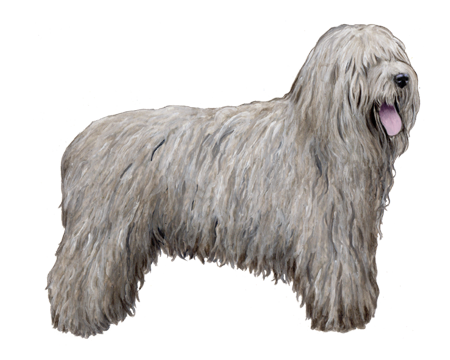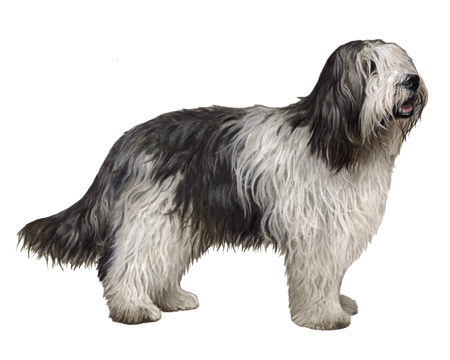
Catalan Sheepdog
The Catalan Sheepdog is an alert, courageous working dog and a loyal, affectionate family pet. Add to that the breed's cheerful attitude, adorable facial hair, and friendly smile, and it's easy to see why these dogs are growing in popularity!
Interested in discovering if your dog is a Catalan Sheepdog?
Check out Wisdom Panel's DNA tests.

Catalan Sheepdog Traits
General Appearance
The Catalan Sheepdog is medium-sized with balanced proportions and a sweet, smiling face.
Coat and Coloring
The breed has a luxurious straight or slightly wavy double coat. When they blow their coats, Catalan Sheepdogs first shed hair on the front half of their bodies only. For a brief period—before the back half takes its turn shedding—the dogs appear to have two different coats.
The Catalan Sheepdog's coat is sable, fawn, or grey and often mixed with reddish-brown, black, or white hairs.
Distinctive Physical Traits
These dogs sport adorable beards, mustaches, and tufted eyebrows. The breed also has wide, expressive eyes, an alert, intelligent gaze, and a long, low, furry tail. (Some Catalan Sheepdogs naturally have no tails.)
Catalan Sheepdog Temperament
Catalan Sheepdogs are good-natured, energetic working dogs. These courageous pups possess a natural desire to care for their sheep and an ability to make instinctual decisions when monitoring the flock. They're also well-suited to work in any weather conditions—it's never too hot, too wet, or too chilly for these dogs to do their jobs.
At home, Catalan Sheepdogs make loyal family members. They're usually good with children (provided adults supervise) and friendly with other dogs and pets. They can, however, be wary of strangers.


Catalan Sheepdog History
As the name implies, the Catalan Sheepdog—also known as Perro De Pastor Catalán or Gos d'Atura Català—hails from Northeast Spain in Catalonia. Stories suggest the breed came about when Romans brought their dogs to Spain and crossed them with native Catalan dogs. The resulting dogs worked with shepherds, helping guard and herd their livestock.
Unique and still relatively rare, Catalan Sheepdogs worked in the Spanish Civil War as messengers and sentry dogs. Their popularity fell after World War II. But selective breeding programs in the 1970s helped the breed recover. Today, Catalan Sheepdogs are popular in their native Spain, and their numbers continue to grow in Germany, Sweden, and Finland.
The United Kennel Club recognized the Catalan Sheepdog in 2006. Three years later, the Kennel Club recognized the breed and added it to the import register as a working dog.
Catalan Sheepdog Care
Nutrition
Catalan Sheepdogs need a diet formulated for their life stage (e.g., puppy, adult, senior). A food made specifically for medium-size breeds will have the appropriate blend of nutrients for their size and activity level.
Since all dogs are at risk for obesity if they eat too many calories, carefully monitor the amount of food you give your pup. Portion out their meals with a measuring cup to prevent overfeeding, and limit treats to no more than 10% of their calories.
Grooming
You should brush your Catalan Sheepdog's coat a few times a week to prevent mats and tangles. During seasonal shedding periods, you may need to brush daily to keep the hair under control (and off your sofa).
Nail trims and ear cleanings are also important parts of any dog's grooming routine. Lastly, make sure you keep your pup on a life-long dental care program that includes at-home teeth brushing and professional cleanings.
Exercise
Catalan Sheepdogs are working dogs by nature. That means they need plenty of exercise and mental stimulation every day. Long walks, runs, and romps in the backyard are excellent ways to keep them active. Dog sports—such as agility, rally, and obedience—are also productive outlets for the breed's high energy and intelligence.
Training
Catalan Sheepdogs are smart, hard-working canines that respond well to training. Positive reinforcement and consistency are the best tools for teaching this breed commands and tricks.
In addition to obedience training, early socialization is a crucial step of raising a well-behaved dog. So, be sure to introduce your pup to different people, places, and situations when they are young to help them grow into a friendly, predictable adult dog.

Breed Group
Herding
The herding group is a diverse category. These highly intelligent breeds were developed to guard and control the movement of livestock.
Resources
http://www.fci.be/Nomenclature/Standards/087g01-en.pdf
https://catalansheepdogclub.co.uk/about-catalan-sheepdogs/
Reviewed September 5, 2020 by Laura Inman, DVM























































